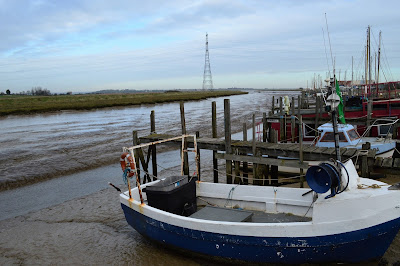 |
| One of my favourite sights - Ramsgate Harbour. |
 |
| Yes, this was taken in December! |
I have recently returned from a five-and-a-half week trip to Ramsgate, in the South-East of England, to spend Christmas with my family.
Returning home is always an odd thing after so many years living elsewhere. On the one hand, it is and will always be home and I feel comfortable as soon as I am there. On the other hand, it has undergone changes during my absence and so a part of me feels like an outsider.
 |
| Ramsgate Beach, the morning of New Year's Eve. |
But in Ramsgate, every morning I could go on a long walk through old neighborhoods, ending up at either the East Cliff or the West Cliff, then winding my way down to the harbour and back up through the town. A three or four mile walk with a dose of refreshing sea air. Walking is just easier and more pleasant there.
 |
| One of the windier days on the cliffs. |
 |
| The Phoenix Queen - an artist's houseboat that resides in Ramsgate Harbour |
This was also my first time home since the opening of the wartime tunnels and so, a few days after our arrival, Nic and I made our way along there before they closed for the Christmas season.
 |
| The entrance to the Ramsgate Tunnels |
Growing up in Ramsgate, I always knew about the labyrinth of tunnels that wound their way under the town and through the surrounding cliffs. Some - used by smugglers centuries ago -connected caves at Pegwell to long-forgotten outlets in Manston. Others were more recent - former railway tunnels, and those used as shelters during World War II. With entrances scattered around town, some intrepid explorers made their way down from time to time to see what remained.
The entrance shown in the photo was originally part of a railway tunnel, built in 1863 for the railway line that served to bring daytrippers down to the Ramsgate sands, dropping them off just feet from the beach. The railway line is now long gone, the main station having relocated to more than a mile away.
 |
| A replica of a typical family's living quarters in the tunnels. |
For the last few decades, a group of dedicated locals have tried to get support for reopening parts of the tunnels as a museum. Finally, in 2014, the Ramsgate Tunnels opened. At present, a little over a mile of tunnels are open. It is hoped that more might eventually be cleared and made safe for visitors. Sadly, despite the opening of the wartime military HQ under Dover Castle, the secret wartime Navy base under Ramsgate (HMS Fervent) is expected to remain off limits for the foreseeable future.
 |
| The original signage for the tunnel railway. |
The tunnels hold particular interest to me, not just because of their location in my hometown but also because of their connections with my dad's family. The museum features photos of his dad, who served in North Africa, and of other ancestors who were instrumental in the town's early lifeboat rescue service. Other family members operate the tea room, while another served as our tour guide.
After watching a short video, we donned our hard hats to walk the tunnels, viewing some of the entrances, reading the graffiti left by past generations, and hearing stories of life underground during the war.
 |
| Arklow Square Entrance |
 |
| The tunnel beneath Victoria Road |













